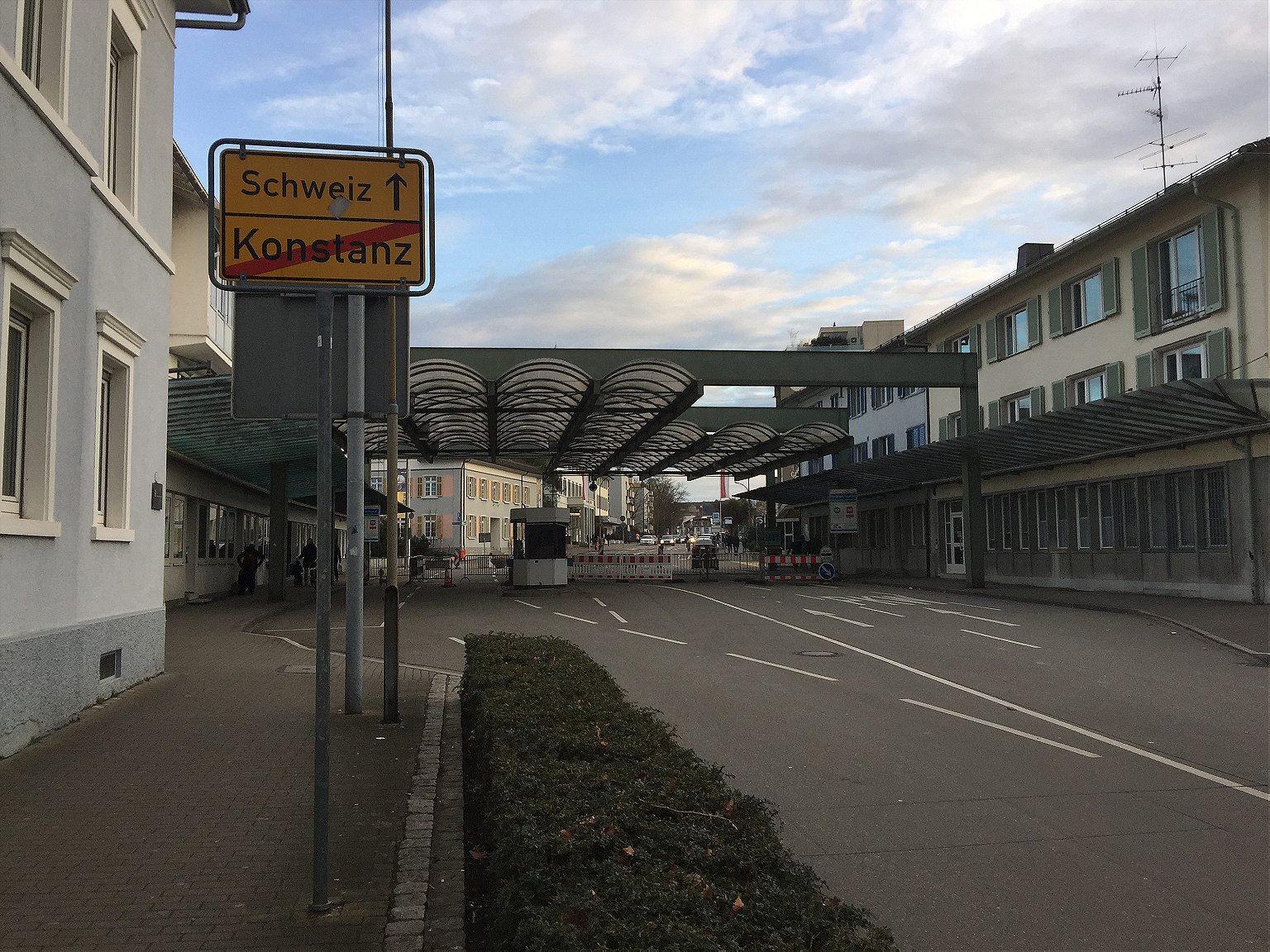The unexpected effects of an open border, an ailing euro, and German sales-tax policy on one border city.
You don’t shop on Saturday if you live in Konstanz, Germany, a 1,400-year-old city of 83,000 people where the Rhine meets the Bodensee. That’s when carloads of Swiss shoppers queue up to get waved into Germany, single-file, by bored border guards. Thousands of others enter less ceremoniously on foot or bike.
They are largely headed to one destination: the five-story (plus seven levels of parking) Lago Center. Opened in 2004, the massive mall includes a nine-screen megaplex and all the dining options you could want. The Swiss visitors pick clean the racks of cut-rate continental couture at the H&M. They leave bare the shelves at the low-end Aldi supermarket. And they make Konstanz’s multiple branches of the DM toiletries chain absolute hell, lining up a half-dozen deep, their shopping carts overflowing with organic toothpaste, name-brand diapers, and pomegranate-scented conditioner.
The border between the twinned cities of Konstanz in Germany and Kreuzlingen in Switzerland was established during the outbreak of World War I, but aside from the war years, the border has historically been a formality rather than a real barrier for citizens of Germany and Switzerland. It faded into irrelevance yet again in 2008 when Switzerland joined Europe’s nominally passport-free Schengen Area. Today, that freedom of movement has been embraced by Swiss shoppers looking for a bargain.
Though the border may be open, Switzerland is not a member of the European Union and uses the Swiss franc rather than the euro. Switzerland boasts the continent’s highest average consumer prices, and the effects of a near-parity exchange rate mean that Germany generally has cheaper prices for groceries, toiletries, and household goods. A shopping basket full of products that would cost 167 francs ($165 in U.S. dollars) domestically would cost about €104 (U.S. $110) in Germany, according to Switzerland’s own federal statistics office. The same shoddily made H&M hoodie costs 39.95 francs in Kreuzlingen but just €24.99 at the chain’s two branches a half-mile away in Konstanz. It was hardly surprising in 2015 when Swiss–German public radio listeners voted Einkaufstourist, shopping tourist, the word of the year.

Though Schengen allows for theoretically seamless movement, the currency border has created a visible rupture. In addition to the major retailers in and near the mall, German businesses have found niches with cheap pan-Asian cuisine, smoker-friendly pubs for value-minded drinkers, and even P.O. boxes that allow Swiss to order German products online and collect them steps from the border without paying international shipping fees. Kreuzlingen, in contrast, optimistically rebranded its Hauptstraße (Main Street) the “Boulevard,” but without shoppers who can afford to shop there, has struggled to find long-term tenants for such an ambitiously upscale address.
Kreuzlingen came into existence in the 12th century, by decree of a Catholic bishop from Konstanz who ordered a monastery built on the farmland neighboring the old Roman city he oversaw. The towns have had a functional, neighborly relationship from the beginning. A decade and a half ago, it was the Germans who idled in border lines to tank up on cheap Swiss fuel at the 15 gas stations built largely to entice them over—and indulged in fancy food products to bring home.
“It was always more expensive here,” Jost Rüegg, a Green member of the regional Parliament, says over coffee in downtown Kreuzlingen. “But people loved chocolate, they loved good coffee, quality pasta. There were certain things that Germans bought here because they were better. And now, with the euro, that has shifted.” In fact, the two cities’ commercial relationship has become almost completely one-sided.
Over the course of a decade marked by credit and currency crises, the euro has lost 37 percent of its value against the franc. And Switzerland’s shopping tourists get more in Germany than a favorable exchange rate and lower prices: They can also take advantage of a value-added tax rebate. Non–EU residents, including the Swiss, can claim VAT back on most purchases at the end of their shopping trips—meaning that, save for tax-exempt food products, their day at the mall costs considerably less than it would even for residents of Germany.
“I find it fully incorrect of Germany that they give the value-added tax for every product back at a rate of 19 percent,” says Rüegg, a Kreuzlingen native who will turn 70 this year. “I mean, that is a fifth of the price.” He advocates against the VAT scheme as part of an organization called KAMS. “We have written to politicians in Bern and told them: ‘Talk with the Germans so that they do away with this value-added tax rebate,’ ” he says. “That is what’s wrong—not the euro rate or the franc rate. The value-added tax rebate must be eliminated. It leads to mass consumption, and that is unhealthy, and the state can intervene here and should intervene; it supports consumption, and it unfairly, one-sidedly supports Germany.”
Konstanz’s discounts have become a devil’s bargain for Kreuzlingen.
Konstanz’s discounts have become a devil’s bargain for Kreuzlingen, which is nowadays best described as pricey, and quiet, and quiet because it’s pricey. It’s a city where the already limited options for entertainment—a pizza, say, or a pint—cost 50 percent more than they do across the line in Konstanz, and often much more. Deal-seekers from as far away as Bern, two hours southwest and Switzerland’s de facto federal administrative capital, traverse the Bodensee border town en route to Konstanz’s chain shops.
“The weak euro—or too-strong franc—has only increased the problems that businesses face in Kreuzlingen,” says third-term Mayor Andreas Netzle, who took office in 2007. “Our stores had already long felt the effects of the lower prices in neighboring Konstanz and the value-added tax rebate. For Kreuzlingen’s residents, all three factors are a great lure, even more than before, to go shopping in Konstanz. What we could not predict was the massive shopping tourism that goes directly through our city en route to Germany without our own businesses being able to profit from it at all.”
Repackaging Germany’s borderlands as a day-trip destination for Switzerland’s shopping tourists has had negative effects on Konstanz, too—both aesthetic and on the municipal morale. From the Rhine to a few hundred feet before the border, quaint and cobblestoned Konstanz is exactly the Europe of tourists’ imagination. If you stick to the narrow pedestrian streets that wind outward from the square surrounding Konstanz’s cathedral, which was built in phases beginning in the 7th century (and unlike its counterparts in Munich and Dresden, was spared Allied bombs in World War II), you can stay in that Europe, nipping into cave-like wine taverns where the locals complain about streets clogged with cars with Swiss license plates. However, once you emerge on Konstanz’s main square, perhaps buzzed on the southern Rhine’s regional wines, the extent to which German and international chains have overrun the otherwise-enchanting Gothic center becomes soberingly clear.
H&M’s freestanding downtown branch sits just a quarter-mile from the two floors it occupies in the Lago shopping center. Knickknacks and novelty items your thing? Nanu-Nana’s Lago shop is just 1,200 feet from its other downtown digs. The Osiander bookstore chain offers the same selection at two outlets around the corner from each other. (To Konstanz’s credit, it does have a handful of independent bookshops in its city center.) However, the DM one-stop toiletries chain has made the most aggressive claim to old town Konstanz. The chain currently has a large shop in the Lago Center and another a two-minute walk away, just off the main square, plus two more branches in town.
DM now plans to open a fifth store on Konstanz’s main square just 400 feet from its existing downtown shop, and in a move deeply unpopular with locals, it has displaced a beloved nearly 80-year-old independent art house cinema to do so. “This isn’t for Konstanzers,” says Elisabeth Grübel, a 30-year resident who joined protests against the repurposing of the cinema. “We can satisfy our toothpaste, toilet paper, and shampoo requirements elsewhere. The Konstanzers don’t need these branches—and we are getting even more tourists.” Grübel says she’s not especially eager to head to the Lago for any reason: “So long as there are smaller shops in the old city, I’ll go to those.”

When Switzerland’s Saturday rush comes, Grübel will often head in the other direction. To save cash, she’ll pack a lunch and a thermos full of tea, and take the train right through Kreuzlingen, to the nature that is Switzerland’s most affordable draw. She cross-country skis the forests surrounding Kreuzlingen when there’s snow and hikes them when there’s not. Occasionally, she’ll splurge on a coffee in town and find someone from Konstanz doing the pouring, earning entry-level francs to spend like the Swiss back home. “The servers are German, and the cafés are empty,” Grübel says, “because everyone Swiss is in Konstanz.”
In addition to the opportunities for bucolic jaunts and barista jobs, there may be more and more reasons for Germans to spend time in Kreuzlingen again. “Money wins in Konstanz,” says Benni Kreiblich, a 33-year-old native of the city. “Unfortunately,” he adds, “there’s no value placed on quality and culture.”
Two years ago, Kreiblich and a group of friends decided to make a go of filling what they considered one of Konstanz’s gaping cultural voids—and they did it in Kreuzlingen. Three nights a week or so, the best, and often seemingly the only, action in town can be found at the Horst Klub, which Kreiblich and his friends describe as “the only ’60s-styled DIY hangout in town.”
The Horst Klub is collectively run, and it serves as a sort of clubhouse for the towns’ nonconformists, offering skate workshops to local kids on indoor ramps by day and cheap beer and wild rock n’ roll for wayward adults after dark. Whether working or just hanging out, most members commute the mile from the border on skateboards, by bike, or on foot.
“In Konstanz, they don’t want something like this at all,” Kreiblich says. “It’s so strict in Konstanz, and there’s not a lot for younger people,” he adds. “In Kreuzlingen either, really, but when someone creates something in Kreuzlingen, they don’t make it so difficult like Konstanz does. They let you do it, and as long nobody complains they don’t breathe down your neck.” Basically, he says, “it’s just easier in Kreuzlingen.”

Perhaps “it’s just easier in Kreuzlingen” would make a good municipal motto for a city seeking to retain its existing businesses, and replace the ones that have been forced to close, while its neighbor seems intent on attracting more and more branches of international chains to its increasingly less-charming center. Last fall, Kreuzlingen announced an “urgent measure” to create a temporary use agency to place businesses and nonprofits in the proliferation of vacant storefronts—call it an empty-windows strategy to combating an ebbing civic pride. That will be implemented this spring, and the town hopes to tout its success stories by the fall.
“The situation on the Boulevard is difficult, though there are once again new tenants in the shops that have gone empty,” Mayor Netzle says. “Unfortunately, the retail mix is not very attractive—there are too many real estate agents, clothing chains, and mobile phone shops.”
Netzle laments that “even for consumers in relatively well-heeled Switzerland, the price is the deciding criterion.” Still, he says, his quiet, pricey city in a country with a too-high-performing currency has its pluses, even when competing with the German retail mecca across an open border and an anticompetitive VAT scheme on top of that. For one, “we sense that people are deciding that the shopping experience has greatly suffered in overfull Konstanz.” And he points out, in contrast to Konstanz’s cart-clogged cash registers, “There aren’t any lines in Kreuzlingen.”
Top image: A view of St Stephens Church in Kreuzlingen, with Konstanz (and Germany) in the backgroud. Photo by: Pingelig/Wikipedia Commons
